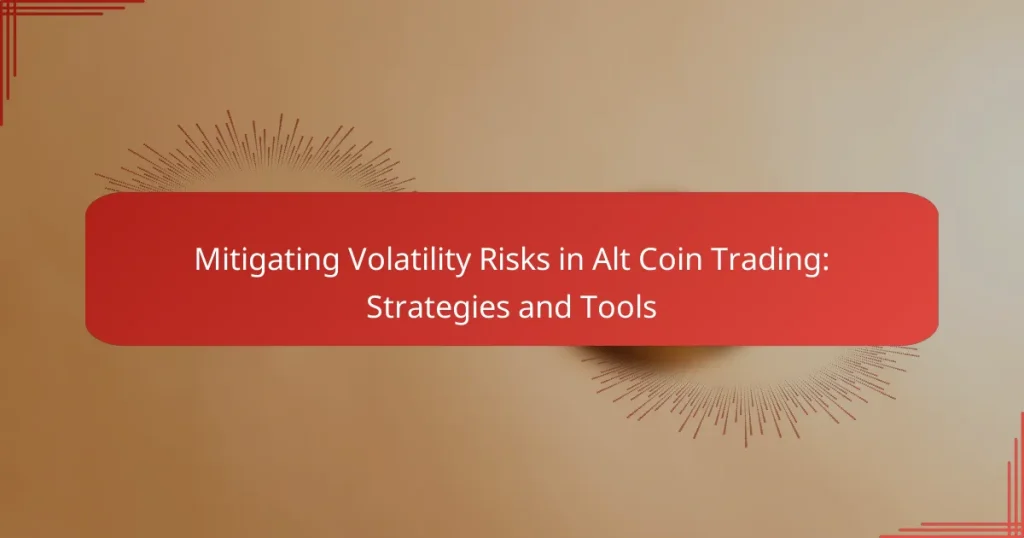Mitigating volatility risks in altcoin trading requires a strategic approach that stabilizes investment outcomes and minimizes potential losses. By implementing techniques such as dollar-cost averaging, stop-loss orders, and portfolio diversification, traders can navigate the unpredictable nature of altcoin markets more effectively. Additionally, utilizing automated tools for market analysis and risk assessment can enhance decision-making and reduce the impact of emotional trading.
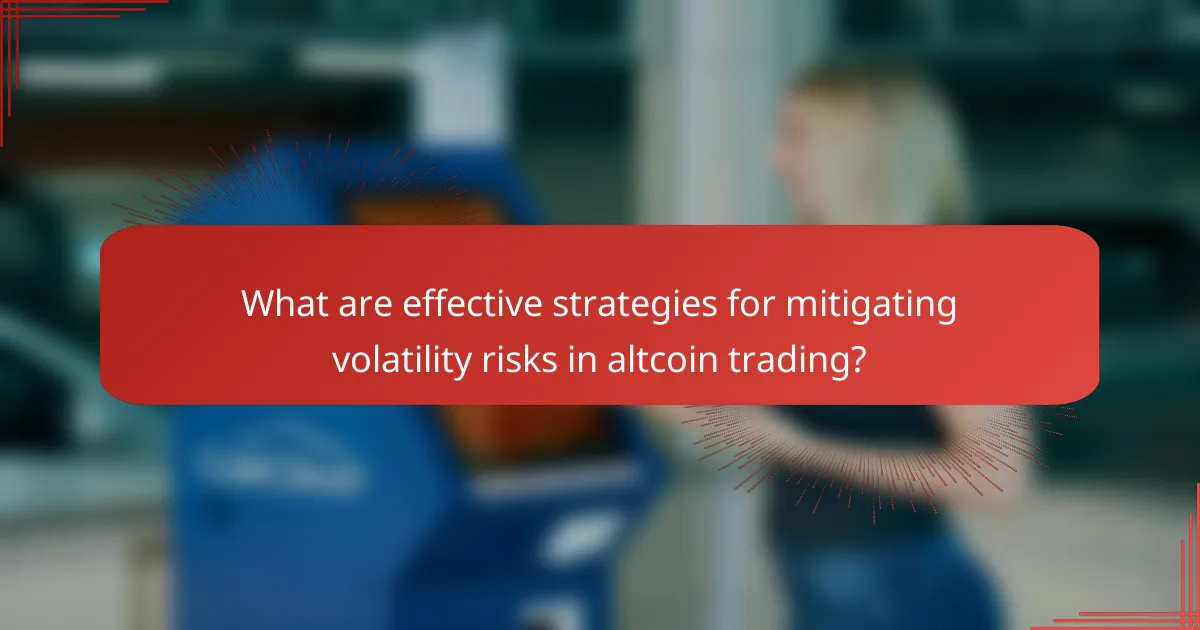
What are effective strategies for mitigating volatility risks in altcoin trading?
Effective strategies for mitigating volatility risks in altcoin trading include employing techniques that stabilize investment outcomes and reduce potential losses. By using methods such as dollar-cost averaging, stop-loss orders, and portfolio diversification, traders can better manage the inherent risks associated with altcoin markets.
Dollar-cost averaging
Dollar-cost averaging (DCA) involves investing a fixed amount of money into altcoins at regular intervals, regardless of their price. This strategy helps reduce the impact of volatility by spreading out purchases over time, which can lead to a lower average cost per coin. For example, instead of investing $1,000 all at once, a trader might invest $100 every week for ten weeks.
This approach minimizes the risk of making a large investment at a peak price and can be particularly effective in volatile markets. However, it requires discipline and a long-term perspective, as the benefits may not be immediately apparent.
Stop-loss orders
Stop-loss orders are automated instructions to sell an altcoin when its price falls to a predetermined level. This tool helps limit potential losses by exiting a position before further declines occur. For instance, if a trader buys an altcoin at $50 and sets a stop-loss order at $45, the asset will automatically sell if the price drops to that level.
While stop-loss orders can protect against significant losses, they may also trigger during temporary price fluctuations, leading to premature selling. Traders should carefully choose their stop-loss levels based on market conditions and their risk tolerance.
Portfolio diversification
Portfolio diversification involves spreading investments across various altcoins and other asset classes to reduce overall risk. By not putting all funds into a single altcoin, traders can mitigate the impact of a poor performance from any one asset. A well-diversified portfolio might include a mix of established coins, emerging projects, and even traditional assets like stocks or bonds.
However, diversification does not eliminate risk entirely; it can only help manage it. Traders should regularly review their portfolios to ensure that their diversification strategy aligns with their investment goals and market conditions.
Using stablecoins
Stablecoins are cryptocurrencies designed to maintain a stable value, often pegged to fiat currencies like the US dollar. Utilizing stablecoins can help traders avoid the volatility associated with other altcoins, providing a safe haven during turbulent market conditions. For example, converting altcoins to stablecoins during a market downturn can preserve capital until conditions improve.
While stablecoins offer stability, they may also limit potential gains during bullish trends. Traders should weigh the benefits of holding stablecoins against their investment strategy and market outlook.
Technical analysis tools
Technical analysis tools, such as charts and indicators, help traders analyze price movements and market trends to make informed decisions. Common tools include moving averages, Relative Strength Index (RSI), and Bollinger Bands, which can provide insights into potential entry and exit points. For instance, a trader might use RSI to identify overbought or oversold conditions in an altcoin.
While these tools can enhance trading strategies, they are not foolproof and should be used in conjunction with other methods. Traders should continuously educate themselves on technical analysis to improve their ability to interpret market signals and make timely decisions.

How can traders utilize tools to manage volatility?
Traders can effectively manage volatility in altcoin trading by leveraging various tools designed to automate strategies, analyze market trends, and assess risks. These tools help in making informed decisions, reducing emotional trading, and enhancing overall trading efficiency.
Trading bots for automated strategies
Trading bots are software programs that execute trades automatically based on predefined criteria. They can analyze market conditions and execute trades within milliseconds, allowing traders to capitalize on price fluctuations without constant monitoring.
When using trading bots, it’s essential to set clear parameters for entry and exit points. Many bots allow for backtesting, enabling traders to refine their strategies based on historical data. However, traders should be cautious of over-optimizing settings, which can lead to poor performance in live markets.
Market analysis platforms like CoinMarketCap
Market analysis platforms, such as CoinMarketCap, provide real-time data on price movements, trading volumes, and market capitalization for various altcoins. These platforms help traders identify trends and make data-driven decisions.
Utilizing these platforms effectively involves monitoring key indicators like price changes over different time frames, trading volume spikes, and market sentiment. Traders should also consider using alerts for significant price movements to stay informed without constant checking.
Risk management software
Risk management software assists traders in assessing their exposure to potential losses and helps in developing strategies to mitigate those risks. This software often includes features for setting stop-loss orders and calculating position sizes based on account equity.
To effectively use risk management tools, traders should establish a risk tolerance level, typically not exceeding 1-2% of their total capital per trade. Regularly reviewing and adjusting these parameters based on market conditions can help maintain a balanced trading approach.
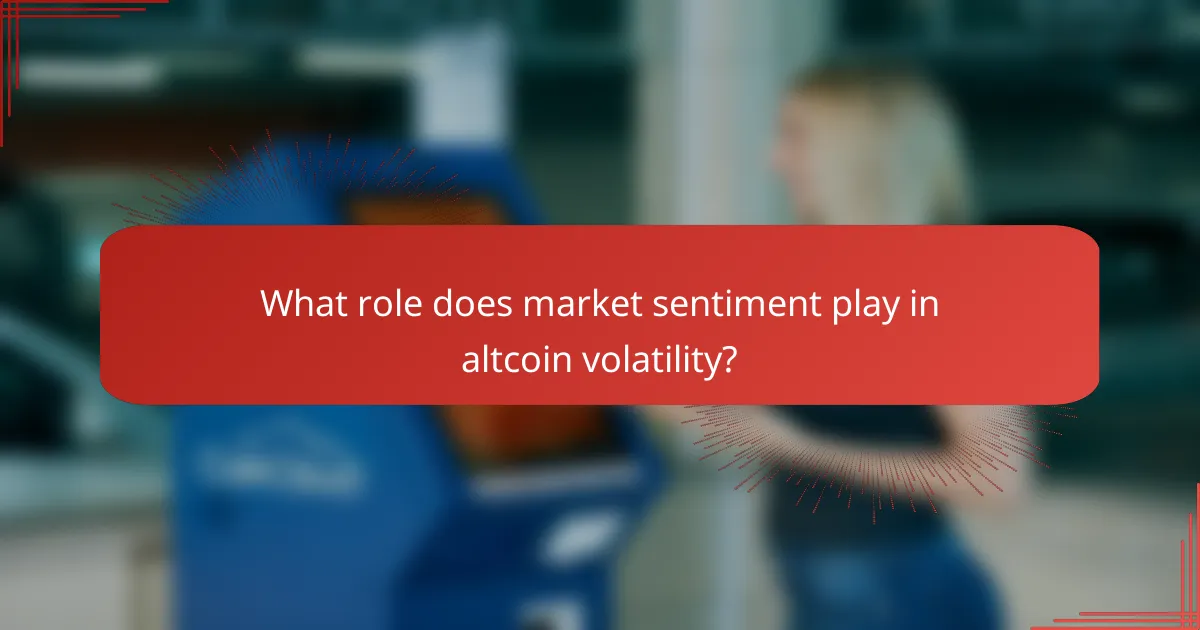
What role does market sentiment play in altcoin volatility?
Market sentiment significantly influences altcoin volatility, as traders’ emotions and perceptions can lead to rapid price fluctuations. Positive sentiment can drive prices up quickly, while negative sentiment can result in sharp declines, making it essential for traders to monitor these emotional cues.
Influence of social media trends
Social media trends can create substantial impacts on altcoin prices, often leading to sudden spikes or drops. Platforms like Twitter and Reddit can amplify positive or negative sentiment, causing traders to react swiftly based on trending discussions or viral posts.
For instance, a meme or influential figure endorsing a particular altcoin can lead to a surge in buying activity, while negative comments can trigger panic selling. Monitoring social media sentiment can provide traders with insights into potential market movements.
Impact of news events
News events, such as regulatory announcements or technological advancements, can significantly affect altcoin volatility. Positive news, like a major exchange listing or a successful upgrade, can boost investor confidence and lead to price increases.
Conversely, negative news, such as security breaches or unfavorable regulations, can lead to sharp declines. Traders should stay informed about relevant news and consider its potential impact on market sentiment when making trading decisions.
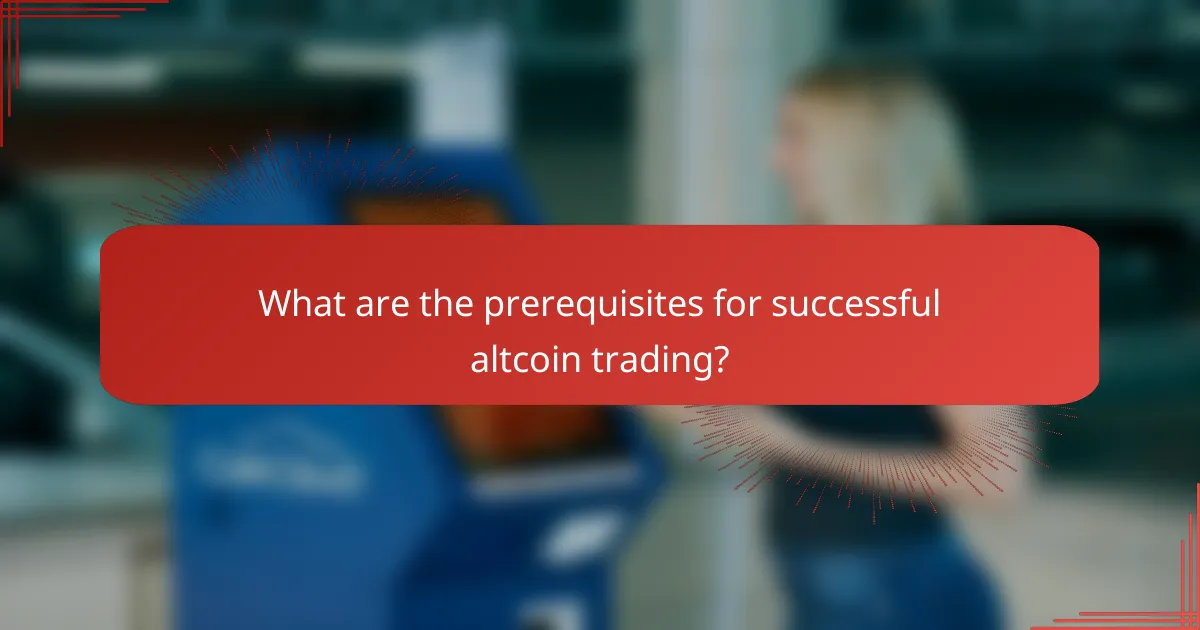
What are the prerequisites for successful altcoin trading?
Successful altcoin trading requires a solid understanding of blockchain technology and market cycles. These foundational elements help traders navigate the complexities of the cryptocurrency market and make informed decisions.
Understanding blockchain technology
Blockchain technology is the backbone of altcoins, enabling secure and transparent transactions. Familiarity with how different blockchains operate, including consensus mechanisms like Proof of Work and Proof of Stake, is essential for evaluating altcoin projects.
Additionally, understanding smart contracts and decentralized applications (dApps) can provide insights into an altcoin’s utility and potential for growth. Traders should research the underlying technology of altcoins to assess their viability and long-term prospects.
Knowledge of market cycles
Market cycles in cryptocurrency often follow patterns of boom and bust, influenced by factors like investor sentiment, regulatory news, and technological advancements. Recognizing these cycles can help traders identify optimal entry and exit points.
Traders should monitor market indicators, such as trading volume and price trends, to gauge the market’s current phase. Developing a strategy that accounts for these cycles can mitigate risks associated with volatility and enhance trading success.
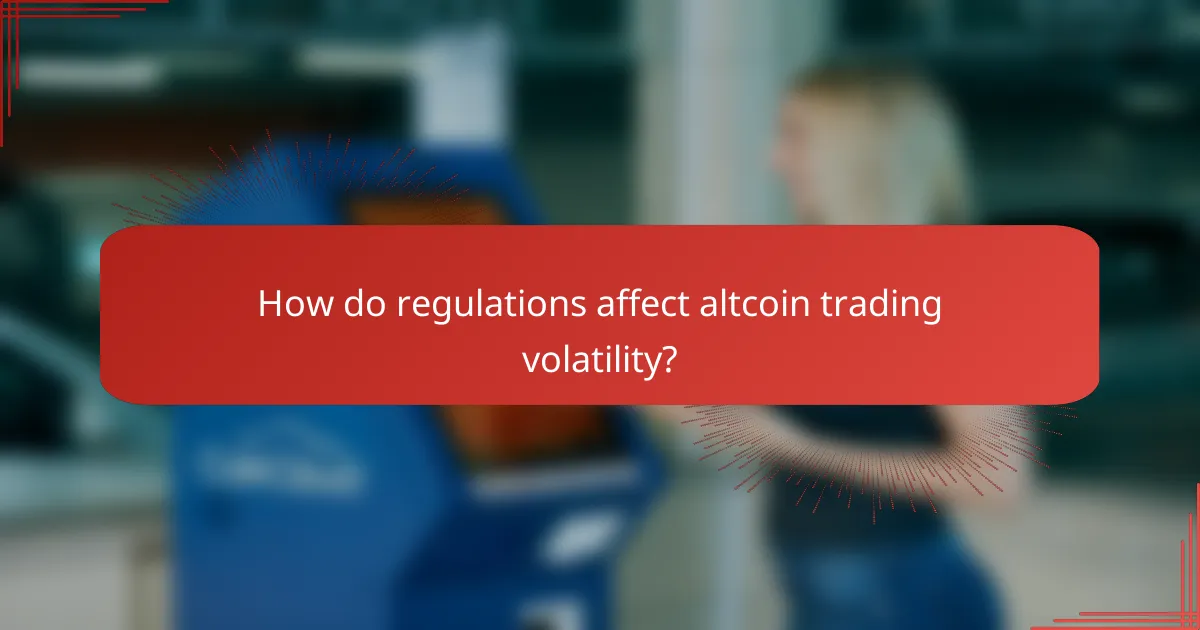
How do regulations affect altcoin trading volatility?
Regulations play a crucial role in shaping the volatility of altcoin trading by establishing rules that govern market behavior. These regulations can either stabilize the market by providing clear guidelines or increase uncertainty, leading to heightened volatility.
Impact of SEC regulations
The U.S. Securities and Exchange Commission (SEC) has a significant influence on altcoin trading through its regulatory framework. When the SEC classifies certain altcoins as securities, it imposes stricter compliance requirements, which can lead to reduced trading activity and increased price fluctuations.
For example, if an altcoin is deemed a security, it may require registration and disclosure of financial information, which can deter investors and create uncertainty. This regulatory scrutiny often results in sharp price movements as traders react to news or changes in compliance status.
Global regulatory differences
Regulatory environments for altcoins vary widely across countries, impacting their volatility. In jurisdictions with strict regulations, such as the European Union, altcoins may experience less volatility due to investor confidence in regulatory oversight. Conversely, in regions with lax regulations, traders may face higher risks and greater price swings.
For instance, countries like Japan have established clear guidelines for cryptocurrency exchanges, fostering a more stable trading environment. In contrast, nations with ambiguous regulations can see erratic trading patterns as investors navigate uncertainty and potential legal risks.
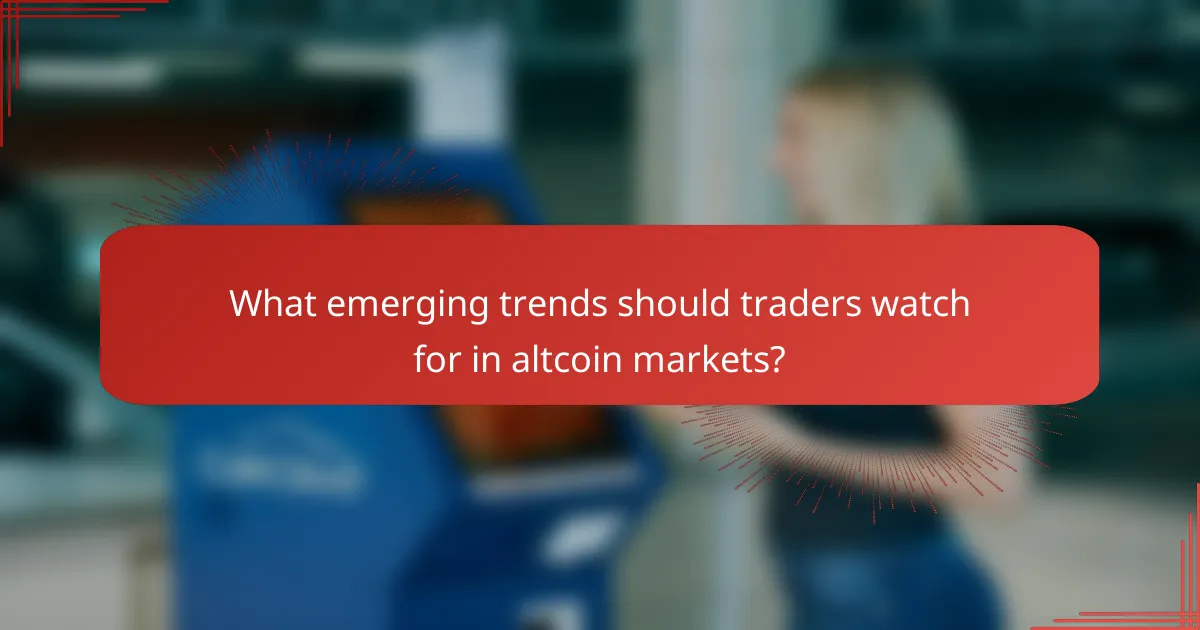
What emerging trends should traders watch for in altcoin markets?
Traders should focus on the increasing adoption of decentralized finance (DeFi) platforms and the rise of non-fungible tokens (NFTs) as significant trends in altcoin markets. Additionally, regulatory developments and institutional interest are shaping the landscape, influencing volatility and trading strategies.
Decentralized Finance (DeFi) Growth
The DeFi sector is rapidly expanding, offering innovative financial services without traditional intermediaries. Traders should monitor the performance of DeFi tokens, as they often experience significant price fluctuations based on market sentiment and protocol developments.
Investing in DeFi can involve risks, such as smart contract vulnerabilities and liquidity issues. It’s essential to conduct thorough research on projects and consider diversifying investments across various DeFi platforms to mitigate potential losses.
Non-Fungible Tokens (NFTs) Popularity
NFTs are gaining traction as unique digital assets, with applications in art, gaming, and collectibles. The volatility of NFT-related altcoins can be pronounced, driven by trends in the art market and celebrity endorsements.
Traders should stay informed about upcoming NFT drops and collaborations, as these events can lead to rapid price movements. Engaging with NFT communities on social media can provide insights into emerging trends and potential investment opportunities.
Regulatory Developments
Regulatory scrutiny of cryptocurrencies is increasing globally, impacting altcoin markets significantly. Traders must keep an eye on new regulations, as they can lead to sudden price changes and affect trading strategies.
Understanding the regulatory environment in your country is crucial. For example, in the European Union, the Markets in Crypto-Assets (MiCA) regulation aims to create a unified framework for crypto assets, which could influence market behavior and investor confidence.
Institutional Interest
Institutional investment in altcoins is on the rise, with hedge funds and corporations diversifying their portfolios. This trend can lead to increased market stability and liquidity, but it may also contribute to heightened volatility as institutional players react to market changes.
Traders should consider the implications of institutional moves, such as large buy or sell orders, which can significantly impact altcoin prices. Staying updated on institutional adoption news can provide valuable insights for trading strategies.
